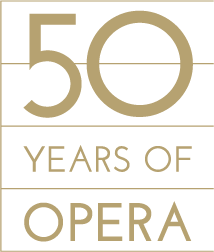This story is part of a series of 50 stories we are releasing to commemorate 50 years of opera in West Michigan. Browse more stories and follow our journey throughout the season.
As someone uniquely familiar with the contemporary opera landscape across the world, go-to musical production consultant Evans Mirageas says we are in the midst of an opera boom.
The Evans Mirageas biopic begins with a tight shot of a soprano’s face, mid-aria. From off-camera, we hear an exasperated “cut!” The camera pans around our soprano to reveal a frazzled director sitting in the front row of the theater, alone. She is shaking her head, her face in her hands. The director wipes her face, looks up, and issues a plea to the ceiling. “Mirageas, where are you?”
Smash cut to Mirageas in his silver Aston Martin, whipping the machine around the curves of a high mountain pass over the ocean. Pavarotti’s rendition of Nessun Dorma booms over the speakers as Big Sur crashes and rages below. “Evans, you have a call from…Opera Grand Rapids,” says the onboard computer. Mirageas smiles.
Another cut, and we are in the interior of Opera Grand Rapids’ rehearsal space. The Pavarotti recording transitions smoothly to a live rendition of Turandot’s final act. The singers are clearly weary, and the director is pacing in tight circles when the door bursts open to reveal Mirageas. Without breaking stride, he leaps onto the stage and begins rearranging the singers before producing and lighting a cigar with a single gesture. The director looks at her assistant and says, “Something tells me we’re going to be just fine.”

Evans Mirageas would doubtlessly take issue with such a fantastic portrayal of his life and times, but the reality of his life’s work is almost as extraordinary, if less Bondesque. Opera News calls him “The Doctor,” a musical production consultant who can arrive on the scene, find the pulse of an organization, and help get a production back on its feet. He is an expert on all things symphonic and operatic, and consults on matters artistic, logistical, financial, and philosophical.
“It’s been my lot for 17 years now to do that kind of work, and I love it,” says Mirageas. “I like helping institutions and individuals find their way out of a tight corner or chart a new path.” His wide-ranging career has included working for Decca Records, countless consultation gigs, and many leadership positions in the world of classical music. He holds two concurrent jobs: he is V.P. of Artistic Planning and Operations at the Atlanta Symphony Orchestra, as well as the Harry T. Wilks Artistic Director of Cincinnati Opera. “It’s a joy and a real challenge to do both jobs sometimes. The Symphony is fall, winter, and spring, and the Opera is in the summer.” Somehow, Mirageas also assists in some advance planning for the Montreal Symphony, and helps the Mann Center in Philadelphia coordinate its summer classical program.
As someone uniquely familiar with the contemporary opera landscape across the world, Mirageas is very hopeful about the opera’s future. It’s understandable to have anxieties about a 400-year-old art form arriving in the digital age, but Mirageas says we are in the midst of an opera boom. “For operagoers in North America, we are in something of a golden age.” He explains that we are still producing plenty of opera’s ABCs—Aida, Bohème, and Carmen—across the continent, but there has been an incredible flowering of creativity among composers and librettists in the last 20 years as well. Mirageas finds himself staggered at the sheer amount of opera being produced today.
“These are not going to be works that are done once and put on the shelf, either,” he says. Mirageas points to Kevin Puts’s Silent Night and Jake Heggie’s Dead Man Walking as recent classics that have entered the contemporary repertoire. “I think composers have realized their music is nothing without an audience. As one famous wag once said, ‘There’s still a lot to be said in C major.’ That doesn’t mean that this is simplistic music, or that we’re doing Broadway shows with operatic voices. These are genuine operatic creations that pay homage to the artform that has existed for over four hundred years, but it’s taking it forward.”

Beyond aesthetic evolution, something else is changing the way modern opera is being performed. Mirageas says that there are more works than ever before being written for smaller casts and nontraditional spaces. “Many composers are writing intimately scaled works,” he says. “Meaning that a whole range of opera companies, not just the behemoths of New York, Chicago, San Francisco, and LA, can have access to modern, engaging, stimulating operatic work.” Mirageas cites Cincinnati’s own commissioned work, Fellow Travelers, as an example of commanding piece with a relatively small cast. “It was designed to be done with 13 players, nine singers and no chorus,” he says. Composers are writing for smaller venues and companies for reasons both practical and artistic. “Sometimes, stories suit themselves to that. Not everything is Aida, with grand political moments and a triumphal chorus with all soloists singing as loudly as they can. Some of the most exciting work I’ve seen has been up close and personal.”
It is telling that Mirageas addresses trends in composition and production size before talking about technology’s role in opera’s future. Opera’s core will always be about the music and the people performing it. But technology can supplement a great production artistically and logistically. “In 1910 you didn’t have motorized winches. You would need three stagehands to pull a heavy set piece up. Now it goes with ease. A lot of the technological advances are things the audience never sees.” Most advancements behind the curtain have allowed the grandiosity of opera to scale subtly over the decades. On stage, though, it is mainly the evolution of projection technology that is giving artistic directors an increasingly vivid and animated palette of options. “When used with artistic impulse, projections are terrific,” says Mirageas. He recalls the flurry of (projected) cherry blossoms during the duet of the same name from the Atlanta Opera’s production of Madame Butterfly as being astoundingly beautiful. “To me, the advances in scenic technology are nothing but a boon, unless they are just used to say, ‘Look ma, no hands.’” Mirageas says such spectacle must be artistic first, and spectacular second. “Technology is our friend, as long as it’s used judiciously. A great painter shows restraint in using that extra brushstroke.”
Concerns about technology, the economy, and changing tastes have always plagued discussions of the performing arts, and opera in particular. It’s understandable. But Evans Mirageas has an unusually high vantage on the world of opera, and he is nothing but optimistic about its future. When he looks over the audience of his opera company, he sees Millennials, Gen-Xers, Baby Boomers, and octogenarians alike in their eagerness for the curtain to open, and he knows that the future of opera is a bountiful one.

OUR FOUNDERS HAD A BOLD PROPOSITION: to build a professional opera company that would put Grand Rapids on the map for a very discerning audience. 50 years later, we are humbled to be the modern bearers of classical standards and modern ingenuity. Learn more.
SUPPORT OUR NEXT 50 YEARS
As an integral part of our city’s artistic fabric, it’s our responsibility to see to its continual flourishing. Please consider donating to Opera Grand Rapids to ensure our artistic excellence for the next 50 years and beyond. You’ve already made us great. With your support, there’s no limits to the height our voices can reach together. Give today.








